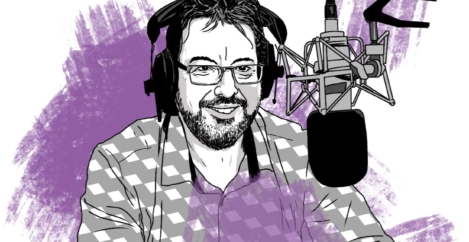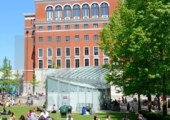June 24, 2024
Sound and vision – Nigel Oseland makes himself heard for the IN magazine profile
Interviewing people involves trying to tease out a bit of personal colour. Sometimes I already know what that is or might be. That is certainly the case with Nigel Oseland who I have known for many years, know to be from Wolverhampton and who studied psychology and computer science at Keele University in my home town. He went on to focus on environmental psychology while working at the Building Research Establishment in Watford in the late 1980s and 1990s.
This coincided with one of my own first roles in the workplace sector just a few miles down the road in Radlett. It’s very likely our paths crossed then although I don’t recall. He now has his own consultancy, runs an annual conference with his wife Maggie is a visiting fellow of Liverpool John Moores University and is a sought after speaker and commentator in the media and events worldwide.
Nigel is a connoisseur of beer as well as prog and indie rock and is prepared to act on both passions. He is the founder and organiser of a beer festival in his adopted home of Berkhamsted and the presenter of a weekly show on Radio Dacorum.
Apart from our professional relationship, the latter keeps me in regular contact with him because each week he appeals for ideas for the theme of that week’s show – be it songs with gaps in them, songs about the weather, or whatever.
This does throw up a slight generational mismatch because although I generally share his taste for both genres, I am ambivalent about the folkier end of the prog canon and he doesn’t share my appreciation for the likes of The Wedding Present and Half Man Half Biscuit. My suggestions on social media based on this love fall on deaf ears.
One thing we do agree on is that many of the most important insights we can have about work and workplaces are rooted in disciplines such as psychology and anthropology. He is one of those academically minded people who applies research in a practical way, an ability that is far rarer than it might be.
This is evident in the Workplace Trends conference he runs with his wife Maggie, one of the must attend events in the annual calendar of such things.
He is also the author of two books. The Human Zoo views people and their behaviour in the workplace through an anthropological lens. His most recent book has the much drier title of A Practical Guide to Post Occupancy Evaluation and Researching Building User Experience. But it too is there to offer actionable insights.
The publication is timely because the conversation about the workplace has now crossed over into mainstream thinking. Firms and their managers are taking a far keener interest in the design and management of the workplace in all its forms.
All about people
“What we all understand now is that it’s all about people,” he says. “It’s about how the design of an office and work culture supports them. But we can do more and that’s what I am trying to do with the book. You can point things out with anecdotes and you can point them out with data. Without the data you haven’t really got a conversation and when you’re talking to the C-suite you really need it. If you’re the world’s foremost expert on a subject or a signature architect or whatever, you always have sway, but us mere mortals need the data.
“Executives have their ideas and their visions which they will pursue and those are necessary. But they also need a broader perspective, a broader viewpoint. Sometimes they don’t always know as much as they might about what is happening with the people who work for the business. When we do surveys, we often find that business leaders have a different view of how the office is working to other people. If you have the data, you have the conversation. If you have data, you might still be challenged but without it, you’re screwed.”
Nigel believes that this new focus is also changing the way we talk about corporate real estate. “The focus of real estate has always been space and cost efficiencies and that’s the wrong starting point,” he says. “The starting point should be, well, how are people using the office, how do we want them to use the office? How do we attract them back? Do we need a completely different model of work? During the COVID crisis there was an understandable focus on taking tactical decisions in response. Now we’re thinking more strategically.
“But there are still vestiges of the tactical response. Weirdly, I went into a university space the other day and they still had Perspex screens up between their desks. I think the staff liked it. It’s back to the cubicle except it’s a Perspex box rather than a partitioned box.
“So, when we look at post occupancy evaluations we’re still not always doing it right. The measurement of success is still often about whether it was delivered on time and within budget. But it’s changing. More and more firms are asking whether it actually works for them. Is it meeting occupants’ requirements? Are the buildings behaving in the way they were designed and modelled for from an energy and sustainability perspective?”
Toes in the water
He is also aware of how firms are still tentatively exploring new ways of working and looking to see what others are doing to get some sort of guidance. “I am seeing a big split between organisations who are saying no, we’re going back to five days a week with dedicated desks for everybody, or maybe we’ll let people work at home on a Friday afternoon or whatever.,” he says.
“But on the whole, people are only in the office two or three days a week. So those organisations look at unallocated desking and hot desking and so on. And with all that uncertainty we need to be measuring more than ever and collecting all the right data to ensure we are making the right calls.
“One of the most sought-after metrics right now – and it wasn’t like this before COVID – is utilisation. People are voting with their feet and if the office doesn’t offer them a better experience than their homes or doesn’t make travel worthwhile. The challenge is getting the balance right. One research project I’ve worked on with Miller Knoll and presented at the last Workplace Trends found that people who don’t have an allocated desk are less likely to come back to the office.
“This is important to understand because one of the ways we are addressing the issue of underutilised space is with desk sharing. But according to our research, that makes it even less likely people are going to come into the office. And so, utilisation drops even more. We might have already suspected this. It’s always been a struggle to sell hot desking to people.”
In true academic style, Nigel always caveats such statements and points out that things are more complicated. “We have to break it down by different types of people,” he says. “We know a lot about introversion, extraversion and different personality types. There is a large group of people, including many of the workplace strategists I know, who are advocates of desk sharing. Because that’s how they want to work. They want to socialise. They want to collaborate.
“Then there are the people who are happy to work from home, and move around when they need to. They’re happy to come into the office but don’t want to be pinned down. Sometimes they don’t even want to sit next to their colleagues. Sometimes they do. So there are lots of people who understand instinctively about how to use the office as a club or coworking space.
“But there are others who prefer routine, knowing when they’re going to be in the office, where things are, where their colleagues are, knowing they have their own desk. And many people want to blend how they work. It’s a dilemma.”
Transfer policy
Another dilemma is understanding the context in which people respond to post occupancy questionnaires about workspace. Does he think they will use the feedback to express broader dissatisfactions about their job?
“Yeah. In psychology, there’s a phenomenon known as transference in which you will transfer something you like or grumble about on to something else. So people will say they are dissatisfied with a space, when asked, although the real source of the dissatisfaction is a relocation. One of the ways of identifying this I discovered many years ago is to ask questions about the specific elements that make up a space. And if there are big gaps between the response to those question and the overall level of satisfaction, that normally indicates that something else is affecting their viewpoint.”
So what are the main advantage for firms who undertake a post occupancy evaluation?
“Well, the main reason is to take a systematic approach to a complex issue, rather than relying on anecdotal evidence or personal preference. You can’t just rely on the views of executives or architects and indeed both can benefit from the use of an evaluation to brief the design of the building and adapt it over time.
“Without evidence, the architect may build you something that they like. And they may have a different view to what makes a space great to the average occupant. We are often involved in the pre-project phase to inform the brief. Increasingly we are also involved in post occupancy evaluation to inform the next space or next project.
“The important thing to remember is that buildings are often slow to change but organisations aren’t and technology really isn’t. I suspect that one of the main reasons firms relocate is because after about five or more years, their buildings are no longer supporting them as well as they could.
“Sometimes it’s more effective to move than to refurbish, rethink or retrofit an existing space. To me, it makes perfect sense to do a regular, even annual full evaluation of the facilities and technology and everything else that is supporting people. I know there will be conversations and anecdotes that will raise certain issues but a full evaluation with data can be game changing.
“Having that breadth of data to really understand if a building is still working seems essential. To ask whether something is needed and what the firm should do. It also means you can find the things that don’t need to change. Something the best thing to do is nothing.
“Sometimes what is important seems trivial,” he argues. “It’s not all about time and budget. It can be as basic as giving people good coffee to encourage them to spend more time in the office. So give them the best coffee you can.”
“A lot of problems are behavioural. It’s a lot of what happens. It’s a disconnect between the way the office was designed and the way it’s being used. The briefing is right, the design of the space is right, but fairly often there’s not really enough change management or transition management. So then people don’t use the space the way it was intended. You need to check.”
















